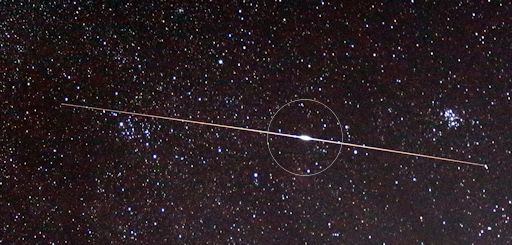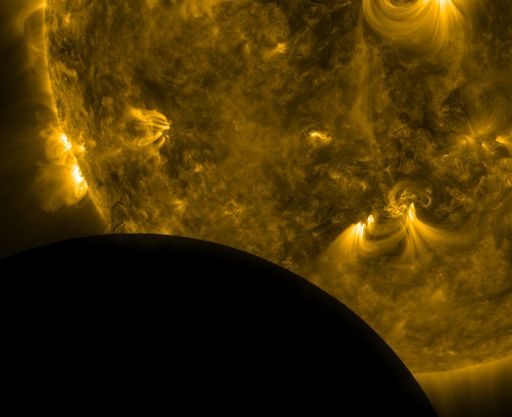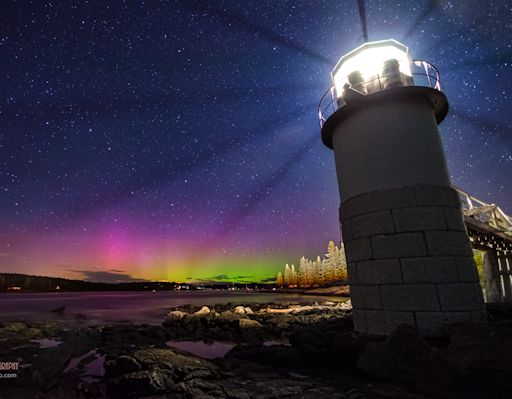They came from outer space--and you can have one! Genuine meteorites are now on sale in the Space Weather Store. | | |
MAGNETIC FIELD REVERSAL ON THE SUN: It hasn't happened yet, but it's about to. Data from NASA-supported observatories show that the sun's global magnetic field will flip before the end of 2013. The reversal, which signals the arrival of Solar Maximum, will have ripple effects felt throughout the solar system. Get the full story and a video from Science@NASA. Solar flare alerts: text, voice.
JAPANESE SPACESHIP FLARES: Launched on August 3rd, Japan's unmanned HTV-4 cargo carrier is now chasing the International Space Station around Earth. The two spaceships will rendevous on Friday, August 9th. Meanwhile, skywatchers are enjoying the chase. Gary of Fort Davis, Texas, witnessed a bright flare from the Japanese ship when it flew over his home town two nights ago:

"Hello Kirobo!" says Gary, addressing the talking robot onboard the HTV-4. "I captured a nice flare as the resupply vessel passed thru Perseus and the Pleiades on Aug. 5th, 2013 at 05:57am. About 12 minutes earlier the ISS had passed thru the same area."
The flare from HTV-4 was caused by sunlight glinting off a flat surface, much like an Iridium flare. No one can predict HTV-4 flares, so every sighting is a surprise.
The next two nights are a great time to see two spaceships in the sky at the same time as the ISS and HTV-4 converge for docking. Download the Satellite Flybys App to turn your smartphone into a field-tested HTV-4 tracker! Flyby predictions are also available here.
Realtime Space Weather Photo Gallery
SOLAR ECLIPSE IN SPACE: Yesterday, August 6th, the new Moon passed in front of the sun, producing a partial solar eclipse. The only place to see it was from space. NASA's Solar Dynamics Observatory (SDO) photographed the eclipse from geosynchronous orbit approximately 36,000 km above Earth's surface:

Using a bank of 16 megapixel cameras, SDO observed the event at multiple extreme ultraviolet wavelengths. Scan the edge of the Moon in this 171 Å image: The little bumps and irregularities you see are lunar mountains backlit by solar plasma.
Beyond the novelty of observing an eclipse from space, these images have practical value to the SDO science team. The sharp edge of the lunar limb helps researchers measure the in-orbit characteristics of the telescope--e.g., how light diffracts around the telescope's optics and filter support grids. Once these are calibrated, it is possible to correct SDO data for instrumental effects and sharpen the images even more than before.
Realtime Space Weather Photo Gallery
GEOMAGNETIC STORM: A solar wind stream hit Earth's magnetic field on August 5th, sparking a G1-class geomagnetic storm and auroras over several northern-tier US states. (Subscribers to our space weather alert system were notified that a storm was in progress.) Photographer Mike Taylor watched the display from Port Clyde, Maine:

"The awe-inspiring green and purple colors of the Northern Lights spiked up early on the morning of August 5th while I was shooting the Milky Way down at Marshall Point Lighthouse in Port Clyde," says Taylor. "This photo was taken about 5 feet from the base of the tower."
The storm has subsided, but it could flare up again as the solar wind stream continues to blow around Earth. NOAA forecasters estimate a 40% chance of polar magnetic storms on August 6th. Aurora alerts: text, voice.
Realtime Aurora Photo Gallery
Realtime Meteor Photo Gallery
Realtime Noctilucent Cloud Photo Gallery
[previous years: 2003, 2004, 2005, 2006, 2007, 2008, 2009, 2011]
Realtime Comet Photo Gallery

